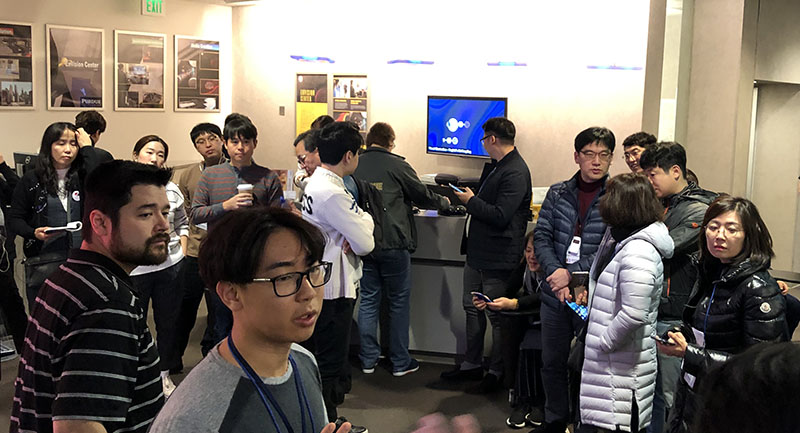Sharing maker culture
Industrial design professor's work inspires Korean maker movement

When a group of Korean citizens visited earlier this semester to learn about U.S. maker culture, they had a perfect tour guide in TJ Kim.
The associate professor of industrial design’s work actually laid the groundwork for a Korean government policy encouraging the development of 350 makerspaces in the country by 2022.
“Everyone’s interested in learning about technology integration and experiential learning in education. It’s a movement that’s happening throughout the whole world right now,” said Kim, a faculty member in the Patti & Rusty Rueff School of Design, Art, and Performance. “We are gradually increasing the importance of maker education in the U.S. [The visitors] saw that and said, ‘This is an opportunity to change the education system in Korea.’ … They see this as a new future in education in preparation for this revolution that’s coming, and this technology integration in education will help them drive smart innovation with our industries.”
The Korean visitors represented a wide variety of interests that can benefit from maker culture. Some worked in education, some in manufacturing. Some worked in technology or ran makerspaces themselves.
“Our group is separated by makerspace user, makerspace owner, and other teachers such as elementary school or high school. But we all have a different point of view,” said entrepreneur Yonghwan Jang, one of the trip’s attendees. “Some of them want to learn about how they come up with their educational things. In my point of view, I’m a makerspace owner. Our government really wants to support us to make various types of makerspaces.”
App developer Kwanghwi Kim also made the trip, hoping to learn about the most effective steps to take in order to establish a co-working space in his hometown of Busan.
“My team has grown, and I need more office space. I really want to make a coworking space in my country, and especially in my city,” said Kwanghwi Kim, who said his iPhone productivity app has built an audience of a million users in South Korea and China. “We rent a big space, and it’s our office and others’. They have come in to collaborate and do their own startup, we do our own startup, and the working space does space. I want to see how makerspaces here are operating and how to do it well.”
Over the course of their 16-day trip, the group visited schools, factories, tech facilities, and co-working spaces across the United States – including stops in California, Chicago, and here at Purdue and the surrounding area.
Kim led the visitors to visit software developer Autodesk and to TechShop, a member-based workshop and fabrication studio in San Francisco. They saw makerspaces like the one housed at Chicago’s Museum of Science and Industry, as well as the Windy City’s non-profit Pumping Station: One, and mHUB. And they were able to visit educational maker programs at a variety of grade levels – from the makerspace class at Northwestern University to the program at Chicago’s Lane Tech College Prep, to the Wonder Lab Jr. that Kim has established locally at Burnett Creek Elementary School.
Kim also brought the guests to Purdue – including a stop at the Envision Center to check out the facility’s virtual reality and data visualization tools – as well as to the Subaru assembly plant and MatchBOX Coworking Studio in Lafayette.
“Part of the education I’m trying to create is the experience factory platform, how we can go to factories and business sites to learn from the industry,” Kim said. “What they are doing? What’s their focus? How can the universities or even K-12 help innovate what they create and manufacture?”
Students in maker programs develop a wealth of skills beyond those required to invent, build, and innovate. They also learn about creative writing, public relations, business planning, and web development as they learn how to publicize the products they create. And they strengthen their math and accounting skills as they learn to crunch the budget numbers on their projects.
“It is about experiential learning by creative thinking, making, and doing, taking thought into action. They are learning different roles in the industry. They don’t know what they will become in the future, but they’re learning it at a young age in middle school. It’s not so much about only focusing on startup. It’s really focusing on helping them know what they are learning now at a young age – math, science, art, and English language – can be used with future job opportunities.”
Kim envisions Purdue as a hub for Midwestern maker culture, with an emphasis on manufacturing. Since many of his colleagues are already studying the future of that industry, he believes Purdue research can provide a perfect complement to the prevalent maker cultures on the American East and West Coasts.
“We are going to try to create a new image for Purdue around smart manufacturing and the future of manufacturing,” Kim said. “It makes sense because the maker movement in the West Coast is more focusing on IT and robotics and the East Coast is more about culture. Here in the Midwest, we are more focused on future manufacturing.
“So a lot of things that the Korean government wants to do is focusing on innovation in manufacturing as a startup,” he continued. “A startup focused on product solutions that can be manufactured as a part of its innovation, integrating technology, finding applications of the new technologies. That’s why they’re interested in coming to Purdue and the Midwest: to learn more about the future of this manufacturing.”